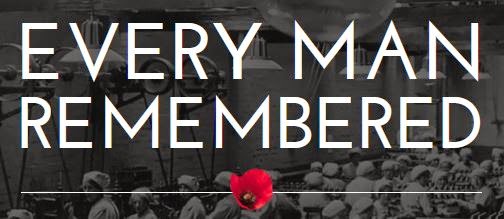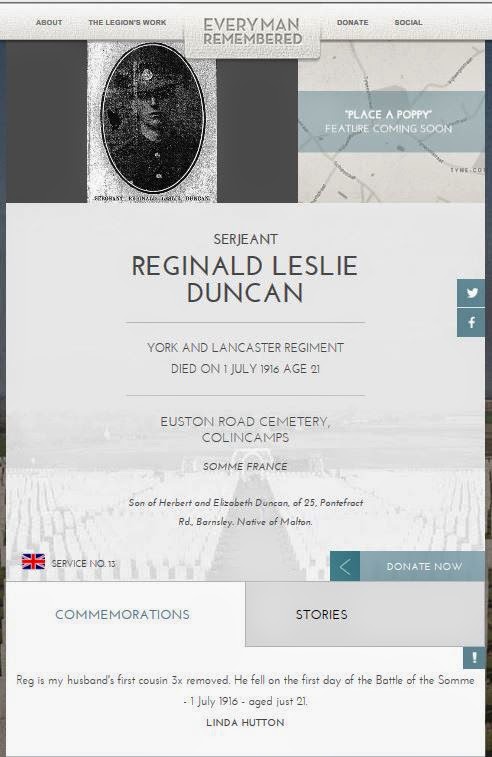 |
| Crossland Barraclough's CWGC entry (from the CWGC website) |
My own grandmother was born in Wallsend in 1907. There will be no connection between the two I'm sure, but simply the coincidence of the place attracted my attention. Easy to distract from 'proper work', that's me, especially in the current heat! It's 24 degrees in our dining room where I'm sitting typing this.
 |
| Crossland is remembered on his father and sister's gravestone in Barnsley Cemetery (photo by PS) |
In Loving Memory Of / Oswald / the dearly beloved husband of / Amelia Barraclough / who died Oct. 16th 1920 / aged 54 years / also Crossland, the only / beloved son of the above / who died from wounds / received in action in Palestine / May 2nd 1918, aged 24 years / also Millicent Edna / their daughter / who died in infancy / Peace Perfect Peace.
We can see that his father, Oswald, died in 1920. So that means that the CWGC entry shown above was compiled after his death as in that he is referred to as 'the late'. There is also a sister who 'died in infancy'. Lots of clues. But why did Amelia end up in Wallsend?
 |
| Crossland Barraclough's SDGW entry (from Ancestry) |
Checking on Ancestry for Crossland's Soldier's Died in the Great War record I see that it appears he lived in Wallsend when he enlisted, but that he actually enlisted in London into the London Scottish Regiment. This agrees with the CWGC entry.
Crossland's Army Service records do not appear to have survived and the Long, Long Trail website, which is usually very helpful about the movements of various regiments can only tell me that the 2/13th and 2/14th (County of London) Battalions arrived in Salonika in November 1916 and then moved to Egypt arriving in Alexandria on 5 July 1917. The 2/14th (County of London) Battalion (London Scottish) moved to France on 30 May 1918, which is after Crossland's death.
 |
| Jerusalem War Cemetery entrance (from the CWGC) |
He is buried in an individual grave in the Jerusalem War Cemetery, which, according to the CWGC, took in graves from battlefields and smaller cemeteries in the neighbourhood. The new documentation on the CWGC site confirms that he was in the 2/14th London Battalion and that his mother paid for the addtional text "Awaiting a Higher Command" to be added to his stone. The record for the Cemetery notes that the advance to Jerusalem took place in autumn 1917 and that the Allied forces formally entered the city on 11 December 1917.
It is hard to say for sure how or when Crossland was injured (he died of wounds according to his SDGW entry), however looking at the other men buried in the same cemetery there are quite a lot from the London Scottish, the London Civil Service Rifles and the London Irish Rifles who were killed at the end of April and the beginning of May 1918 suggesting a battle of some kind. A search of Wikipedia for the dates and area brought back a report on the attack on Shunet Nimrin and Es Salt in which the 60th London Division took part. This is a very detailed report and I will let you go and read it yourselves! It does seem likely that this was the action in which Crossland and his colleagues were killed and injured. There were 1,116 casualties suffered by the London Division from a total of 1,649 British Empire casualties, including Anzac and Australian soldiers too.
The reason that this story caught my interest is the question why the family moved from Barnsley to Wallsend? Another Google search on Crossland's unusual name brought back a listing on a War Memorial at St Peter's Church in Wallsend. So he was also remembered in the area in which his mother was living in the 1920s. I have sent an email to the group researching this memorial asking if they know anything about the family.
A general search on the Ancestry website gave me the information that Crossland Barraclough was baptised in Tankersley on 17 June 1894, his parents (as we know) being Oswald and Amelia Barraclough. As this combination of names is very unusual I have confidence that we have found the right family.
 |
| 1891 census snip for 23 Sheffield Road, Hoyland Nether (from Ancestry) |
 |
| Snip from the 1900 baptism register of St Mary's Church, Woodkirk (from Ancestry) |
 |
| 1911 census snip from 16 Lingard Street, Barnsley (from Ancestry) |
Crossland is working, despite being aged only 16 years, he is a Bursar, a job suggesting the handling of money and which sounds responsible and which could lead to better things. Has he obtained a good post because of his father's position?
 |
| A section of the record for Wallsend Colliery (from DMM) |
We now know that the family were in Wallsend by 1914. We know that Crossland Barraclough enlisted in London (had he moved there to improve his job prospects?) and we know that when the CWGC approached Amelia for about his gravestone that she was living at 31 Beech Grove, Wallsend. This was probably in the early 1920s. Oswald Barraclough died in October 1920, so it was after that, and a search on FreeBMD shows that he dies in Barnsley! Odd. I had assumed he had died in the North East ... a search of the Barnsley Cemetery records show that he died at 54 Sackville Street and that he is the only burial in that grave plot. So Amelia was not buried with Oswald.
Constance Muriel Barraclough may have married a Charles H Davison in Barnsley in 1921 - but as the marriage is not available to check on Ancestry I can't be sure it is the right person. The only death of an Amelia Barraclough that fits Crossland's mother is in Hendon, London in 1933. That seems a bit of a stretch, but I suppose her daughter could have moved down there ...
I am happy to have found out why Amelia's address was in Wallsend after the war, but it would have been nice to have finished the story off properly. Maybe there will be a part 2! You never know.


















